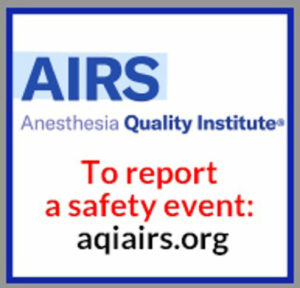INTRODUCTION TO ANESTHESIA INCIDENT REPORTING SYSTEM (AIRS)
 The Anesthesia Incident Reporting System (AIRS) was created specifically to detect rare and novel adverse events that occur in national health care systems in the perioperative period. Events may encompass equipment malfunctions, medication errors, and rare complications in the nonoperating room setting. Over the last 11 years, thousands of detailed event reports and tens of thousands of cases of harm have been submitted, associating an anesthetic with a complication. AIRS uniquely serves as our “canary in the coal mine,” letting us know when something new or rare is occurring across the country.
The Anesthesia Incident Reporting System (AIRS) was created specifically to detect rare and novel adverse events that occur in national health care systems in the perioperative period. Events may encompass equipment malfunctions, medication errors, and rare complications in the nonoperating room setting. Over the last 11 years, thousands of detailed event reports and tens of thousands of cases of harm have been submitted, associating an anesthetic with a complication. AIRS uniquely serves as our “canary in the coal mine,” letting us know when something new or rare is occurring across the country.
Shortly after the launch of AIRS, we received multiple reports of air embolus occurring during endoscopic retrograde cholangiopancreatography (ERCP). The AIRS committee published a case report in the ASA Monitor highlighting this rare, but potentially fatal complication with recommendations to assist in detection and prevention. Over the years these recommendations have been propagated through many educational channels, including the American Board of Anesthesiology’s maintenance of certification questions. This event and a summary of it have also been presented in many Anesthesia Quality Institute (AQI) sponsored panels and other forums. As a result of this attention, ERCPs are now commonly performed with CO2 insufflation to reduce the risk of this event, and gastroenterologists are more careful with dissection. Both parties are more mindful of the risk and better prepared to respond. While a voluntary event reporting system cannot completely determine the incidence of the event, we believe the prevalence may have decreased due to a paucity of reports over the past 10 years.
Without the original AIRS reports there may have been a significant delay in recognizing this complication and educating our specialty. The remainder of this article is a summary of the AIRS system and how the tool can be used to safely report adverse events in any anesthesia practice. It is a professional obligation for all of us, and one way we can work together to improve patient outcomes.
HISTORY OF INCIDENT REPORTING
Incident reporting began locally with initial adoption in the 1930s, typically surrounding unexplained deaths.1 This expanded over time to cases of patient harm, and cases where patients were almost harmed (near miss) by an unsafe condition. Flanagan described the first cases of anesthesia critical or incident reporting in 1954,2 and this technique was introduced in the United States by Cooper et al in 1978.3 Incident reporting is designed to improve patient safety by identifying hazards for improvement. This paradigm has been in use in other industries for much longer than health care and typically in highly reliable applications, such as aviation and nuclear power.
As expected, this work began with mortality and then slowly evolved to capture morbidity. The adoption of systems that capture near misses and unsafe conditions is limited to the current century. Many departments use a paper system to track and discuss cases at a morbidity and mortality conference. However, a formal process with reliable event capture including near misses and unsafe conditions is uncommon. Large hospitals tend to have a process for event reporting; however, as this system is typically not customized to the anesthesia community, the rate of use by anesthesia professionals is quite low.4-7
All clinicians learn from experience in their day-to-day practice. However, this approach has limitations. First, it may be difficult to draw conclusions from a single event. Root cause analysis can be difficult for a sole provider, and even in a group setting, there may be insufficient data to draw a conclusion due to multifactorial causes. Further, this requires that each anesthesia professional experience their own complications, as opposed to many of us learning from the experience of few.
NATIONAL REPORTING SYSTEMS
In order to allow for more robust data analysis, detection of rare events, and to leverage economies of scale, aggregation of events at the national level is desirable. This work began in Australia and New Zealand in 1988 and was later adapted to WebAIRS, a national repository of anesthesia events developed by the Australian and New Zealand Triparate Anesthesia Data Committee (ANZTADC).5,8 In 2011, the Anesthesia Quality Institute (Schaumburg, IL) developed and launched the anesthesia incident reporting system (AIRS) in the United States.5 This system was based on the anesthesia specific taxonomy developed by ANZTADC as well as the very robust local systems in place at the University of California, San Francisco, and Children’s Hospital Colorado affiliated with The University of Colorado.4,5
THE SIGNIFICANCE OF THE PATIENT SAFETY AND QUALITY IMPROVEMENT ACT (PSQIA)
A common concern among physicians is the legal implications of reporting adverse events to local, regional, and national systems. In 2005, the Patient Safety and Quality Improvement Act (PSQIA) became law in the United States.9 This law authorized the creation of Patient Safety Organizations (PSO), of which the AQI as the hosting entity of AIRS is a member. PSOs are fully authorized by federal law to collect patient data and protect it from legal disclosure to support quality improvement work. This law was absolutely critical to the development of AIRS. Data from AIRS is de-identified, and in accordance with the PSQIA, reported to the agency for health care research and quality (AHRQ), which allows the reports generated by AIRS to be used to improve health care overall in the United States. Over the last decade, PSOs have been collecting reports of patient harm, and successfully protecting their participants from discoverability.
TYPES OF AIRS CASES
Cases reported to AIRS are classified by type and specialty, among other considerations. As may not be expected, the majority of cases we receive are focused on three areas: equipment issues, infrastructure/systems concerns, and medications. Pulmonary, cardiac, and airway complications are a much smaller fraction of the reports. When asked as part of the reporting process, the contributing clinicians feel that the reported event was preventable by a three to one margin.
DISSEMINATION OF AIRS CASES
An important output of the AIRS system is monthly newsletter articles summarizing a case and the lessons learned. The AIRS committee members search for interesting and notable cases or trends and through a peer-reviewed process at the committee level produce an
article for the ASA Newsletter. The complete list of all case reports is available at https://www.aqihq.org/casereportsandcommittee.aspx. The articles may be read without subscription at this address.
REPORTING AIRS CASES
C ases of harm or notable near-misses can be reported at aqiairs.org by any member of the anesthesia care team, including trainees or students. The reporting form collects basic demographic information, patient details, and a description of the event. If the reporter prefers, the submission can be made completely anonymously. The form also has a section for lessons learned, and if the case was viewed as preventable by the reporting anesthesia team member.
ases of harm or notable near-misses can be reported at aqiairs.org by any member of the anesthesia care team, including trainees or students. The reporting form collects basic demographic information, patient details, and a description of the event. If the reporter prefers, the submission can be made completely anonymously. The form also has a section for lessons learned, and if the case was viewed as preventable by the reporting anesthesia team member.
In summary, incident reporting at the national level is an important tool to detect, analyze, and learn from adverse events, with the goal of not making the same mistake twice. The PSO framework provides a safe and legal construct to submit the details of an adverse event, protecting the reporting anesthesia professional while fostering quality improvement.
We can’t fix what we can’t detect. Please consider reporting events at aqiairs.org. Ultimately, our patients are the beneficiary of this work.
Patrick Guffey, MD, MHA, is chief medical information officer at Children’s Hospital Colorado and associate professor in the Department of Anesthesiology at the University of Colorado. He is also medical director of the PSO, committee chair for AIRS, and a board member of AQI.
The author has no conflicts of interest.
We thank the members of the AIRS Committee:
Meir Chernofsky, MD
Richard Dutton, MD, MBA
Yasmin Endlich, MBChB
David Gaba, MD
Patrick Guffey, MD, MHA
Brent Lee, MD
Alan Merry, MBChB, FANZCA
Karen Nanji, MD, MPH
David Polaner, MD, FAAP
Mohamed Rehman, MD, FAAP
Keith Ruskin, MD
Lisa Solomon, MD
Avery Tung, MD, FCCM
Tetsu (Butch) Uejima, MD, MMM, FAAP, CPHRM
Joyce Wahr, MD
References
- Beecher HK, Todd DP. A study of the deaths associated with anesthesia and surgery. Ann Surg. 1954;140:2–34. PMID: 13159140.
- Flanagan JC. The critical incident technique. Psychol Bull. 1954;51:327–358. PMID: 13177800.
- Cooper JB, Newbower RS, Long CD, McPeek B. Preventable anesthesia mishaps: a study of human factors. Anesthesiology. 1978;49:399–406. PMID: 727541.
- Kaldjian LC, Jones EW, Wu BJ, et al. Reporting medical errors to improve patient safety: a survey of physicians in teaching hospitals. Arch Intern Med. 2008;168:40–46. PMID: 18195194.
- Milch CE, Salem DN, Pauker SG. Voluntary electronic reporting of medical errors and adverse events. An analysis of 92,547 reports from 26 acute care hospitals. J Gen Intern Med. 2006;21:165–170. PMID: 16390502.
- Guffey P, Szolnoki J, Caldwell J, Polaner D. Design and implementation of a near-miss reporting system at a large, academic pediatric anesthesia department. Paediatr Anaesth. 2011;21:810–814. PMID: 21535298.
- Guffey P, Culwick MD, Merry AF. Incident reporting at the local and national level. Int Anesthesiol Clin. 2014;52:69–83. PMID: 24370721.
- Gibbs NM, Culwick MD, Ferry AF, et al. Patient and procedural factors associated with an incrreased risk of harm or death in the first 4,000 incidents reported to webAIRS. Anaesth Intensive Care. 2017;45:159-165. PMID: 28267937.
- Agency for Healthcare Research and Quality. The Patient Safety and Quality Improvement Act of 2005. June 2008. Accessed December 8, 2020. https://www.hhs.gov/hipaa/for-professionals/patient-safety/statute-and-rule/index.html
Selected References for Additional Review
- Leape LL. Reporting of adverse events. N Engl J Med. 2002;347:1633-1638. PMID: 12432059.
- Cullen DJ, Bates DW, Small SD, et al. The incident reporting system does not detect adverse drug events: a problem for quality improvement. Jt Comm J Qual Improv. 1995;21:541–548. PMID: 8556111.
- Reason J. Human Error. Cambridge: Cambridge University Press; 1990.
- Rowin EJ, Lucier D, Pauker SG, et al. Does error and adverse event reporting by physicians and nurses differ? Jt Comm J Qual Patient Saf. 2008;34:537–545. PMID: 18792658.
- Runciman WB, AF Merry, Tito F. Error, blame, and the law in health care—an antipodean perspective. Ann Intern Med. 2003;138:974–979. PMID: 12809454.


 Issue PDF
Issue PDF PDF
PDF